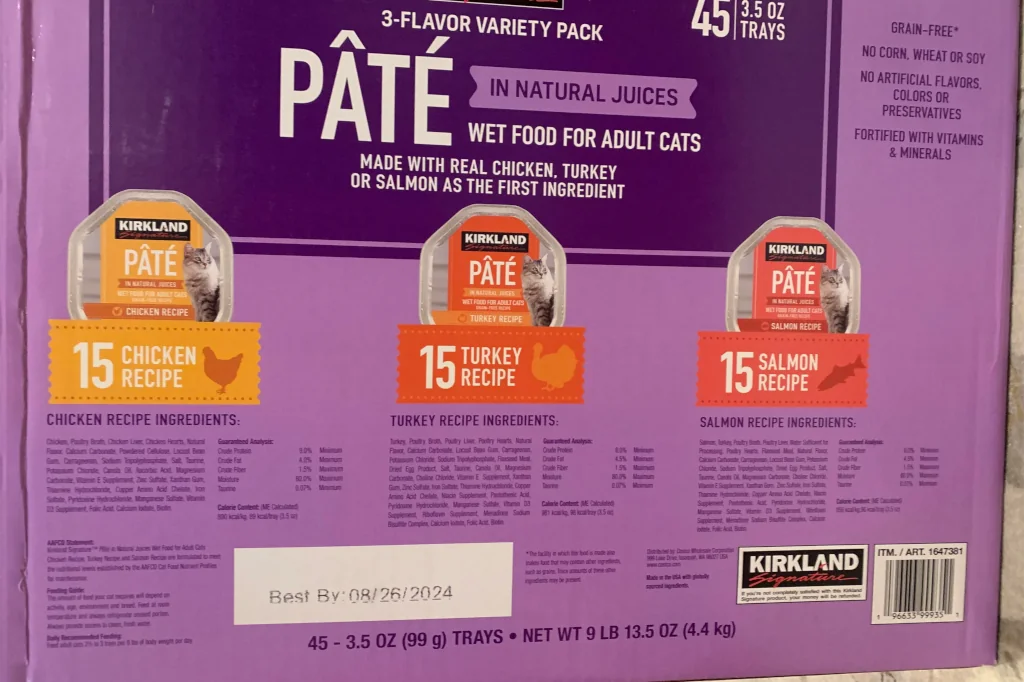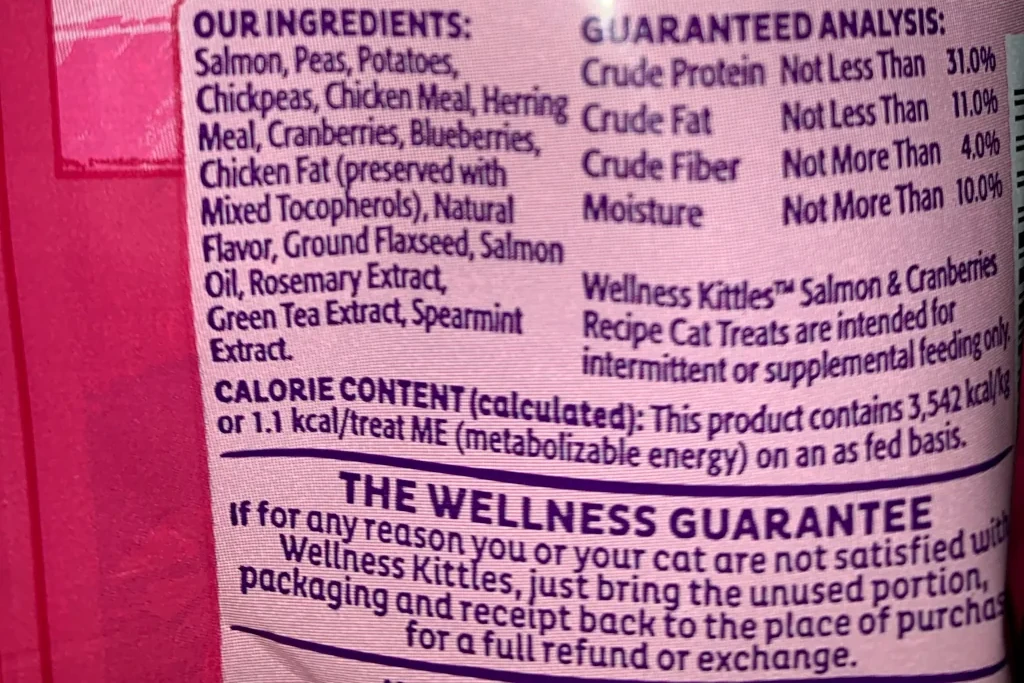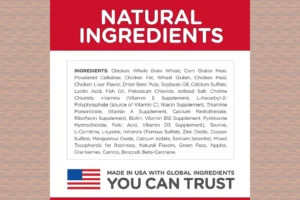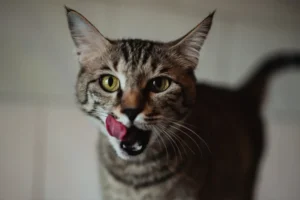Disclosure: We may earn a commission from helpful, relevant links in our content. No cost to you. See our privacy policy.
Decoding cat food labels, huh?
It feels like you need a degree in nutrition or deciphering ancient hieroglyphics to get it right.
The perplexing jargon, the never-ending list of ingredients, and the vague feeding guidelines – it’s a maze out there. Rest assured, we’ve all been in that grocery aisle, cat food tin in hand, wishing we knew more.
This blog post is your guide, your map, to understanding cat food labels. We will slice through the jargon and illuminate the fine print. Let’s turn that grocery aisle confusion into confident selection!

What Should You First Look For on a Cat Food Label?
Take a deep breath, because it’s simpler than it seems.
Your first point of focus on a cat food label should be the product name. Yes, the name! It can reveal much about the food’s actual content.
According to regulations, a food labeled as ‘Chicken for Cats’ needs to have at least 95% chicken. If it’s ‘Chicken Dinner’, ‘Chicken Entree’, or ‘Chicken Platter’, it’s required to contain at least 25% chicken. And when you see ‘with Chicken’? That means it only needs to contain 3% chicken.
For instance, the Wellness Complete Health Natural Grain Free Wet Canned Cat Food is a great example of a product with clear labeling. The name reveals that this product uses high-quality, natural ingredients, and it’s grain-free. The first ingredient is chicken, which indicates it is high-protein cat food.
By simply understanding the product name, you take a big step towards ensuring your furry friend gets what you’re intending to give them. It’s a small insight, but a powerful one. And don’t worry, we’re just getting started. There’s plenty more to learn on this path to feline food mastery.
Common Cat Food Labels and Their Meaning
‘Meat’ vs ‘Meat Meal’
Knowing the difference between ‘meat’ and ‘meat meal’ can make a significant difference in the nutrition your cat gets.
When a label says ‘meat’, it refers to the muscle tissue of the animal. The term ‘meat’ signifies a high-quality protein source, which is crucial for your cat’s health and vitality.
On the other hand, ‘meat meal’ refers to the rendered product from animal tissues, excluding hair, hooves, and feathers, among other things. While ‘meat meal’ might sound less appealing, it can often provide a higher protein content than ‘meat’ alone.
It’s beneficial to have a combination of both ‘meat’ and ‘meat meal’ in your cat’s food to ensure they’re getting both the rich flavors and a high level of proteins.
A product that incorporates both ‘meat’ and ‘meat meal’ is the BLUE Wilderness High Protein Dry Cat Food. This product uses real chicken as the first ingredient, and chicken meal as the second, ensuring your cat gets a balanced blend of real meat and protein-rich meal.
‘By-Products’
While ‘by-products’ might seem like a red flag, they’re not necessarily detrimental to your cat’s health. By-products include non-rendered, clean parts, other than meat, derived from slaughtered mammals.
This usually means organs like the liver, lungs, and kidneys, which are nutrient-dense and often considered delicacies in the wild. However, the quality of by-products can vary significantly.
If you trust the brand and they’re transparent about their sourcing, by-products can be a valuable addition to your cat’s diet. But if you’re uncertain, it’s safer to opt for food labels stating ‘no by-products’.
Related: Cat Food Brands Reviewed
‘Complete and Balanced’
When a cat food label states ‘complete and balanced’, you’re in luck. This term indicates that the food meets the nutritional standards established by AAFCO and includes all the essential nutrients your cat needs in the right proportions.
This term is regulated and requires meeting certain nutritional standards. If you see this label, you can rest assured that the food should provide a comprehensive diet for your cat.
This label is a reliable indicator of quality and balanced nutrition, making it a safe choice for your pet.
‘Grain-Free’ and ‘Gluten-Free’
These terms have gained popularity recently. ‘Grain-Free’ means the product doesn’t contain grains like corn, wheat, barley, rice, etc. ‘Gluten-Free’ means the product doesn’t contain any gluten, a type of protein found in certain grains.
However, it’s important to note that most cats can digest grains and gluten without issue.
Unless your cat has a diagnosed allergy or intolerance, these labels shouldn’t be a primary factor in your decision.
Still, if you prefer to feed your cat a diet more similar to their natural prey-based diet, opting for grain-free could be a valid choice.
‘Life Stage’
While it’s common knowledge that cat food labels often specify a life stage, it’s essential to know why it matters. Each life stage food is specially formulated to meet the different nutritional needs of cats at that stage. Kittens need more protein and calories to support their growth, while senior cats might require fewer calories and more fiber.
Therefore, always choose a cat food labeled for your cat’s current life stage to ensure they’re getting the appropriate nutrients.
Let’s summarize these common terms and what they mean in a table:
| Term | Description |
|---|---|
| Meat | Muscle tissue of the animal, signifies a high-quality protein source. |
| Meat Meal | Rendered product from animal tissues, may provide a higher protein content than ‘meat’. |
| By-Products | Non-rendered, clean parts, other than meat, from slaughtered animals; quality can vary. |
| Complete and Balanced | Indicates that the food meets AAFCO’s nutritional standards. |
| Grain-Free | The product doesn’t contain grains like corn, wheat, barley, rice, etc. |
| Life Stage | Food formulated to meet the nutritional needs of a specific life stage (kitten, adult, senior). |
By understanding these labels, you can better navigate the pet food aisle and make the best choice for your furry friend. Each term conveys important information about the food’s content, nutritional balance, and suitability for your cat’s dietary needs. Happy label reading!
Related: Choosing Dry Cat Food Guide

Which Ingredients to Look for When Choosing Cat Food?
Let’s cut through the confusion surrounding cat food labels. Here’s what to look out for when perusing the ingredient list on the label:
- High-quality protein source. The first ingredient should always be a named source of animal protein, such as chicken, beef, or salmon. Cats are obligate carnivores, meaning they need a high-protein diet primarily from meat sources.
- Taurine. This is an essential amino acid for cats that they cannot produce themselves. It’s crucial for eye and heart health, so make sure it’s included in the list.
- Healthy fats. Look for named fat sources like chicken fat or fish oil. Omega-3 and Omega-6 fatty acids are beneficial for your cat’s coat, skin, and overall health.
- Minimal carbohydrates. Cats don’t need a large amount of carbohydrates. Avoid foods with fillers like corn, wheat, or soy as primary ingredients.
- Added vitamins and minerals. These help ensure your cat is getting a balanced diet. Look for things like Vitamin A, Vitamin B-complex, and essential minerals like calcium and potassium.
- No artificial preservatives, colors, or flavors. Natural is always the way to go for your cat’s health.
Remember, if your cat has specific dietary needs, always consult with a vet for personalized advice.
What Do Feeding Guidelines on the Label Mean?
Feeding guidelines on a cat food label are there to provide a starting point on how much you should feed your cat based on their weight.
However, these are general suggestions and may not perfectly fit your cat’s individual needs.
The feeding guidelines typically show a range of the amount of food to offer per day, depending on your cat’s weight. But remember, these are just averages and your cat’s activity level, age, and overall health status can affect how much they should actually eat.
A sedentary older cat might require less food than an active, young one. A nursing mother cat would need much more. It’s crucial to observe your cat and adjust the portions as needed. Too much or too little can lead to weight problems and associated health issues.
Regular weigh-ins and body condition scoring (a system used to assess if your cat is underweight, overweight, or just right) are also helpful tools. Remember, when in doubt, your vet is the best source for tailored feeding advice.
Deciphering cat food labels might seem daunting at first, but with these tips, you’ll soon be a pro, providing the best nutrition for your feline companion.
The Guaranteed Analysis: What Percentages Matter?
In the world of cat food labels, the guaranteed analysis section provides key nutritional information. However, the values that matter the most may not be the ones you think.
- Crude Protein. Cats are obligate carnivores and need a diet rich in animal-based proteins. The higher the percentage, the better.
- Crude Fat. While fat has a bad reputation, some are essential for your cat’s energy needs. A low-fat diet may leave your cat feeling less than satisfied.
- Moisture. This might seem like a filler, but moisture is critical for cats. They typically don’t drink enough water on their own, so a diet with high moisture content can help keep them hydrated.
- Ash. Here’s where things get interesting, and where most labels fall short. Ash represents inorganic minerals like calcium, phosphorus, and magnesium. While necessary in small amounts, too much ash content can lead to urinary health issues in cats. Unfortunately, ash isn’t always listed, but if it is, lower is generally better – aim for 6-7% or less for dry cat food and below 2% for wet cat food.
- Carbohydrates. Many labels won’t list carbohydrates, but they can be estimated. Subtract the percentages of protein, fat, moisture, and ash (if listed) from 100. The result is an estimated carb content. Lower percentages are better, as cats have limited need for carbs.
For an option that provides a comprehensive guaranteed analysis, consider Hill’s Science Diet Dry Cat Food for adult cats. It lists all crucial nutritional components, including protein, fat, moisture, and ash, and also emphasizes the use of real chicken as the primary ingredient.
How to Compare Different Cat Food Labels?
Comparing cat food labels isn’t as daunting as it might seem. Here are some pointers to help you discern the good from the not-so-good:
Protein Source: The first ingredient should be a high-quality, named meat source. If the first ingredient is a grain or “meal,” it might not be the best choice.
Ingredient Quality: Look beyond the first ingredient. Are there multiple meat sources? Are there a lot of grains or fillers? The overall composition of the ingredients list can say a lot about the quality of the food.
Nutritional Adequacy Statement: This indicates whether the food meets the nutritional levels established by AAFCO. It also specifies the life stage it’s intended for (kitten, adult, all life stages).
Special Dietary Needs: If your cat has specific dietary needs, such as grain-free or low-phosphorus, make sure the label matches these requirements.
Price Per Pound: A simple and valuable tip for comparing cat foods. Divide the price by the weight of the bag or can to determine the cost per pound. This can help you find the most cost-effective options without compromising quality.
When in doubt, consult your vet. They can provide valuable insight tailored to your cat’s unique needs. Remember, the healthiest food for your cat is the one that meets their nutritional requirements and one they’ll happily eat.
Related: How to Choose the Right Wet Cat Food
FAQs
What are ‘by-products’ in cat food?
‘By-products’ in cat food refer to non-rendered, clean parts, other than meat, from slaughtered animals. They include nutrient-rich organs like the liver, lungs, and kidneys.
What does ‘Grain-Free’ mean on a cat food label?
‘Grain-Free’ on a cat food label means that the product doesn’t contain grains such as corn, wheat, barley, and rice. It’s often favored by owners of cats with specific dietary needs or allergies, but generally, cats can easily digest grain and gluten, just fine.
Are artificial colors and preservatives harmful to my cat?
Artificial colors and preservatives in cat food can potentially cause adverse reactions in some cats, including allergic reactions and digestive issues. Natural ingredients are generally healthier for your cat.
What does ‘all life stages’ mean on cat food labels?
‘All life stages’ on cat food labels means the food is formulated to meet the nutritional needs of cats at every stage of life, from kittens to seniors. However, specific needs can differ, so consulting a vet is recommended.
What does the ‘95% rule’ mean for your cat’s food?
The ‘95% rule’ for cat food stipulates that at least 95% of the total weight of the food, excluding water for processing, must be the named ingredient on the label. For instance, if the label says ‘Chicken Cat Food,’ 95% of the food should be chicken.
Alex, a passionate animal lover, has experience in training and understanding animal behavior. As a proud pet parent to two dogs and three cats, he founded AnimalReport.net to share insights from animal experts and expand his knowledge of the animal kingdom.




